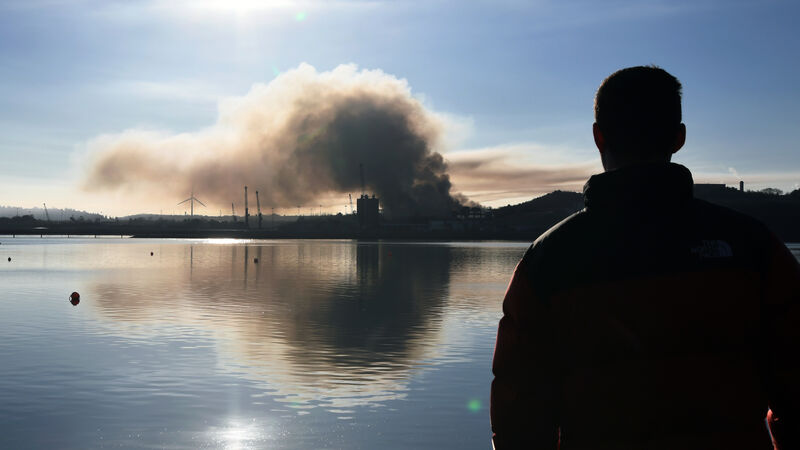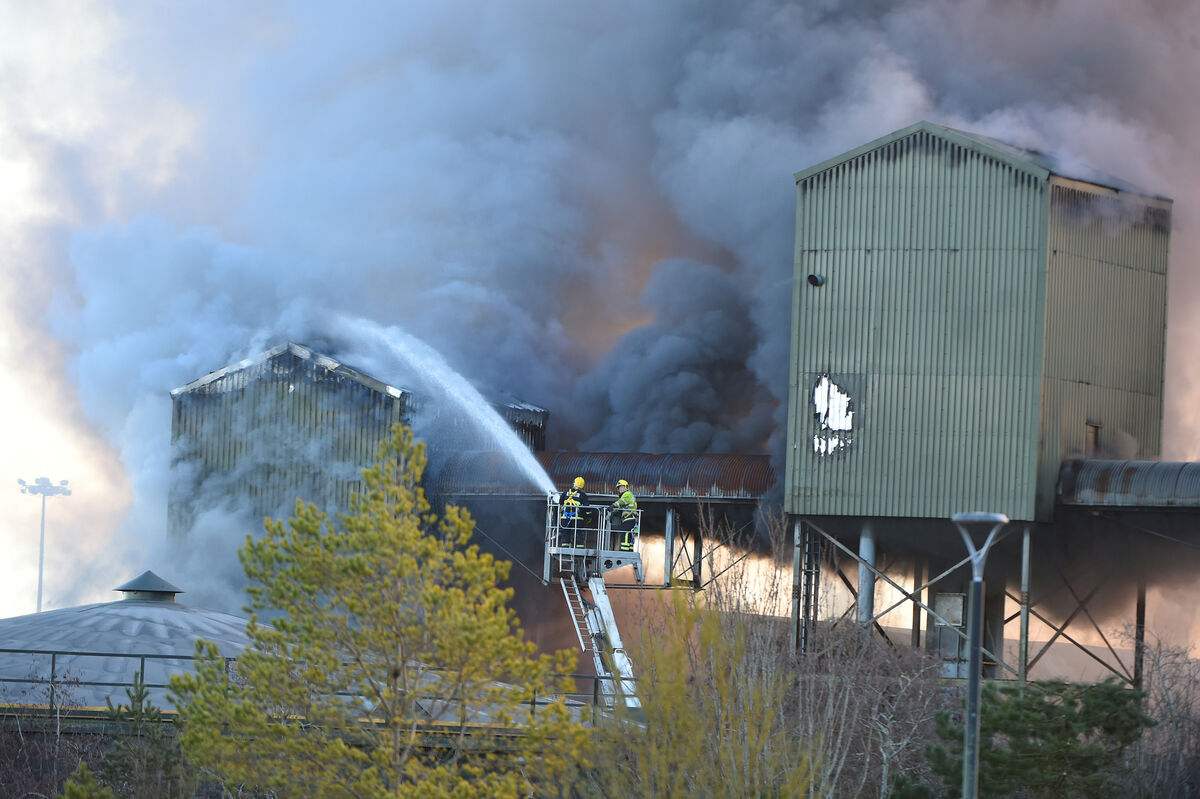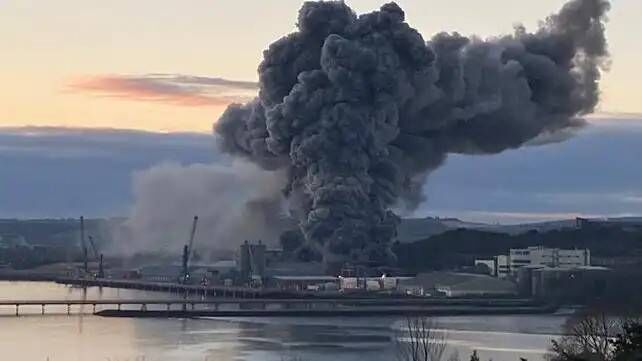Port of Cork blaze prompts calls for air monitors and emergency communications

They said the huge smoke plume from the R&H Hall fire at the Port of Cork’s deepwater compound in Ringaskiddy shows what could happen if there was an accident or explosion at a chemical plant in the area or at the proposed Indaver incinerator.
But residents of the lower harbour said they had to rely on their own contacts to find out what was going on at the height of the emergency response.
A technical glitch in the Environmental Protection Agency’s network of air quality monitoring stations prevented public access to real-time data on air quality during the blaze.
Green Party councillor Dan Boyle said if the data from such a system is not accessible during an emergency, then it is of little use.
“We must have a system that’s capable of live monitoring during a time of crisis,” he said.
He described the glitch as a “massive own goal” on the part of the EPA.
He also pointed out that the EPA has two monitoring stations in the Cobh area, on the opposite side of the harbour, but none in the industrialised Ringaskiddy zone.
Local Independent councillor Marcia Dalton said the fire was the third notable air quality-related incident in Cork Harbour in a week — there was a smaller fire on Haulbowline Island on January 3 and a dust-cloud incident during ship-unloading operations two days later.
She said the impacts of these incidents were felt in Passage West, Ringaskiddy, Coolmore, Crosshaven, Minane Bridge, and beyond — but not at Cobh where the EPA monitors are.
“So once again, no matter what happens or what is said by any councillor or any agency, no data will have been gathered,” she said.
Firefighters yesterday spent a second day tackling the largest fire in the area in almost 30 years.
Fires were still burning inside the R&H Hall grain storage building at the Port of Cork’s deepwater port facilities in the industrialised area of Ringaskiddy, more than 24 hours after the alarm was first raised.
On-scene commander, Chris Gledhill, the station officer at Carrigaline Fire Station, said while the fire was fully under control since mid-morning on Saturday, flames were still visible to the rear of nine of the building's 11 giant grain storage compartments.
He said it was still too dangerous to commit firefighters to the building, so panels were removed from its badly damaged super-structure to allow access to the still-smouldering hot-spots from an elevated position.
Plumes of smoke continued to billow from the port compound for a second day as dampening-down operations continued.
All ship operations in Cork harbour have been suspended temporarily as a fire continues to burn at a large animal feed warehouse in Ringaskiddy. | Read more: https://t.co/v6V3BpYa4V pic.twitter.com/js0wFc4hKz
— RTÉ News (@rtenews) January 9, 2021
"The material involved remains unchanged and is a natural, organic animal feed," a spokesperson for Cork County Council said. "Fire crews will remain on site until this operation is fully complete."
In a statement, R&H Hall said they spent the weekend liaising with the emergency services and with the Port of Cork.
"We would like to thank the emergency services and the Port of Cork team for their quick response and ongoing management of the incident," the firm said.
“We would also like to apologise to local residents, neighbouring businesses, and our customers for any inconvenience caused by the incident."
But the has learned that firefighters were called to two smaller fires at the same R&H Hall building in the last four months.
It is understood that one of those fires was linked to a mechanical problem with a conveyor belt system.

Gardaí and the Health and Safety Authority have launched separate investigations into the cause of the blaze, but initial indications suggest it is not malicious.
The alarm was raised just before 8.45am on Saturday when a giant plume of smoke soared above the deepwater port compound. It was visible up to 20km away.
Dramatic images and video began to emerge on social media of a building ablaze, sparking concerns that it could have been one of the pharma-chemical buildings.
#fire fighting in #ringaskiddy at a grain store @echolivecork @irishexaminer pic.twitter.com/ZfI6IDwsAs
— Dan Linehan (@lensdan) January 9, 2021
Two units of the Cork County Fire Service from Carrigaline and one from Crosshaven rushed to the scene.
“When our pagers went off, and I went outside to make my way to the station,” said Mr Gledhill.
The R&H Hall grain storage complex was well ablaze when the firefighters arrived.
The Port of Cork used social media to advise people to close windows and doors and remain indoors, and it later suspended all shipping operations in Ringaskiddy as a precaution.
A fire has broken out at the R&H Hall grain store on the Ringaskiddy Deepwater Berth. Emergency Services are on site and the Port Emergency Plan has been activated. Local residents are advised to keep all doors and windows closed and remain indoors.
— Port of Cork (@PortofCork) January 9, 2021
Mr Gledhill said the blaze was so severe, they could not commit firefighters to the building, and instead tackled the fire defensively.
An aerial platform from Midleton was requested to help fight the fire from a height.
They managed to bring the blaze under control at around 11am, but smaller fires continued to burn inside the building.

Mr Gledhill called in a fire crew from Cobh and an incident command unit from Bandon, with more than 30 firefighters on-site at the height of the firefighting operation. Three units from the National Ambulance Service were on standby at the scene.
HSE officials were also on-site to monitor potential smoke pollution, but the wind carried most of the plume eastwards, away from residential areas in and around Ringaskiddy.
A fire crew from Kinsale remained on site overnight before dampening-down operations resumed on Sunday morning.
Shipping operations also resumed at the deepwater facilities.
Braham Brennan, chairman of the Ringaskiddy and District Residents Association, said it was the biggest fire in the area since the explosion and fire at the Hickson's chemical plant in 1993.
He said local residents were glad that no-one was injured, but he criticised the lack of information from the various authorities, especially at the outset of the incident.
Locals had to rely on personal contacts, rather than on any formal communication channels or system, to find out what was going on, he said.
“We have been looking for a safety plan for the area for years, and we still don’t have it," he said.
In a statement, the residents’ association said people were concerned about potential toxins in the air and about communications to the public.
“Lack of communication played a significant role in the early stages of this event, where residents had to make calls to Port of Cork operations with their concerns for their own safety,” it said.
“Ringaskiddy Residents’ Association immediately advised residents to remain indoors and keep doors and windows closed until it was determined what was burning and if it was safe to remain in the area — eventually Port of Cork advised the same.”
“The association is not in receipt of any emergency plan for the area despite a previous request for one from Cork County Council and, having a number of pharmaceutical plants, including SEVESO sites, in the area.
Local Fianna Fáil councillor Seamus McGrath plans to raise the emergency communications and planning issue with council officials today.
"The communication with the local community was very inadequate," he said.
"The extent to which an emergency plan was activated remains unclear and questions will need to be answered.
“It was very fortunate that the wind was not blowing in the immediate direction of Ringaskiddy village.
"If it had been, the risks could have been far greater and was there a clear plan to deal with such a scenario.”
The Cork Harbour Alliance for a Safe Environment (CHASE) said that the fire in Cork harbour highlights the unsuitability of Ringaskiddy site for the proposed Indaver incinerator.
In a statement, CHASE said that the fire "provided real-life modelling of dispersal patterns in low winds with thermal inversion in the enclosed harbour basin.
"This saw the plume drift around and sit in inlets and on homes and it continues to do so a day later.
"In similar conditions this would be the dispersal pattern for highly toxic emissions from a fire or explosion at the incinerator plant, as well as for everyday emissions on an ongoing basis."
CHASE added that the 2016 Oral Hearing for the proposed Indaver plan highlighted that it was "equipped only with enough water for 2 hours firefighting, with a plan to let any fire burn out after that, which makes ongoing toxic emissions a real potential threat."
The statement said that the fire was only brought under control by the response of Carrigaline, Cobh, Crosshaven and Midleton fire services.
"It was made clear at the 2009 Oral Hearing that there is no guarantee that emergency services would enter an incident at the Indaver site."





